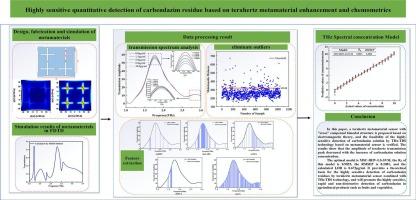Highly sensitive quantitative detection of carbendazim residue based on terahertz metamaterial enhancement and chemometrics
IF 3.4
3区 物理与天体物理
Q2 INSTRUMENTS & INSTRUMENTATION
引用次数: 0
Abstract
Objective
Carbendazim is widely used as an effective fungicide in agriculture, but its residues on crops pose potential health risks to consumers. This study aims to develop a rapid, non-destructive, and highly sensitive method for detecting carbendazim residues.
Methods
Based on electromagnetic theory, this paper presented a terahertz metamaterial sensor incorporating a “cross” compound double-peak structure. Terahertz transmission spectra were collected from 21 different concentration gradients of carbendazim solutions. The spectral response showed a clear decreasing trend in transmission peak amplitude with increasing concentrations. By comparing the results of data preprocessing and feature extraction, the optimal model of terahertz metamaterial detection of carbendazim residue was established.
Result
The related coefficient of prediction set (RP) and root mean square error of prediction set (RMSEP) of this model are 0.9825 and 0.2001, and the Limit of Detection (LOD) is 0.672 μg/mL.
Conclusion
The results demonstrate the feasibility of using terahertz metamaterial sensors combined with spectral analysis for high-sensitivity, non-destructive detection of carbendazim, offering a promising approach for food safety monitoring.

基于太赫兹超材料增强和化学计量学的多菌灵残留高灵敏度定量检测
目的虫脒作为一种有效的杀菌剂广泛应用于农业生产,但其在农作物上的残留对消费者健康存在潜在风险。本研究旨在建立一种快速、无损、高灵敏度的多菌灵残留检测方法。方法基于电磁理论,提出了一种“交叉”复合双峰结构的太赫兹超材料传感器。收集了21种不同浓度梯度的多菌灵溶液的太赫兹透射光谱。光谱响应随浓度的增加,透射峰振幅有明显的减小趋势。通过对数据预处理和特征提取结果的比较,建立了多菌灵残留太赫兹超物质检测的最佳模型。结果该模型的预测集相关系数(RP)和预测集均方根误差(RMSEP)分别为0.9825和0.2001,检出限(LOD)为0.672 μg/mL。结论利用太赫兹超材料传感器结合光谱分析技术对多菌灵进行高灵敏度、无损检测是可行的,为食品安全监测提供了一种有前景的方法。
本文章由计算机程序翻译,如有差异,请以英文原文为准。
求助全文
约1分钟内获得全文
求助全文
来源期刊
CiteScore
5.70
自引率
12.10%
发文量
400
审稿时长
67 days
期刊介绍:
The Journal covers the entire field of infrared physics and technology: theory, experiment, application, devices and instrumentation. Infrared'' is defined as covering the near, mid and far infrared (terahertz) regions from 0.75um (750nm) to 1mm (300GHz.) Submissions in the 300GHz to 100GHz region may be accepted at the editors discretion if their content is relevant to shorter wavelengths. Submissions must be primarily concerned with and directly relevant to this spectral region.
Its core topics can be summarized as the generation, propagation and detection, of infrared radiation; the associated optics, materials and devices; and its use in all fields of science, industry, engineering and medicine.
Infrared techniques occur in many different fields, notably spectroscopy and interferometry; material characterization and processing; atmospheric physics, astronomy and space research. Scientific aspects include lasers, quantum optics, quantum electronics, image processing and semiconductor physics. Some important applications are medical diagnostics and treatment, industrial inspection and environmental monitoring.

 求助内容:
求助内容: 应助结果提醒方式:
应助结果提醒方式:


